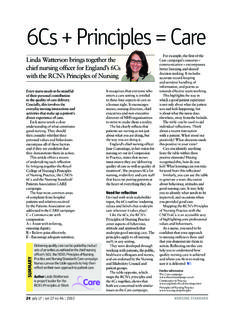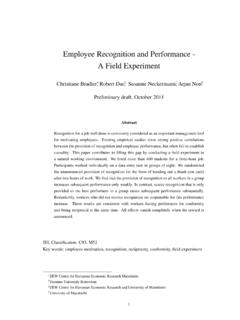Transcription of Reward and Recognition (Second Edition) - ALPS …
1 Reward and RecognitionThe principles and practice of service user paymentand reimbursement in health and social careA guide for service providers, service users and carersThis document is endorsed by:Revised August 2006 Reward and RecognitionThe principles and practice of service user paymentand reimbursement in health and social careA guide for service providers, service users and carersDH INFORMATION READER BOXP olicyEstatesHR / WorkforcePerformanceManagementIM & TPlanningFinanceClinicalPartnership WorkingDocument PurposeBest Practice GuidanceROCR Ref:Gateway Ref: 4567 TitleReward and RecognitionAuthorAlison Cooley/Zo LawrencePublication DateRevised August 2006 Target AudiencePPI Leads, Vol sector organisations,PALS, Social Care organisations,Jobcentre PlusCirculation ListLocal Authority CEs, VoluntaryOrganisationsDescriptionThe principles and practice of serviceuser payment and reimbursement inhealth and social care. A guide forservice providers, service users RefN/ASuperseded Docs271815 Action RequiredN/ATimingN/AContact DetailsZo LawrenceUE&IRoom 5C08 Quarry House, Quarry Hill, LeedsLS2 7UE0113 2546107 For Recipient UseForeword by Liam Byrne MPParliamentary Under Secretary of State for Care Services1 Section 1 Introduction2 Who is the guide for?
2 3 Note on terms used3 Section 2 The principles of good practice4 Section 3 Roles and responsibilities5 Role and responsibilities of the service provider5 Role and responsibilities of the service user7 Role and responsibilities of service users in receipt of benefits7 Section 4 Putting it into practice8 Right from the start8 Section 5 Putting it into practice reimbursement 9 Who is reimbursed?9 Types of expenses10 Expenses and service users in receipt of benefits11 Section 6 Putting it into practice payment13 Levels of involvement13 Who can expect to be paid?14Is there a standard rate of pay?14 Paid involvement: National Minimum Wage and employment law 15 Paid involvement and the benefits system16 Section 7 Voluntary involvement17 Voluntary involvement and employment law 17 Voluntary involvement and the benefits system17 One-off gifts 18 ContentsReward and RecognitioniiiSection 8 Dealings with Jobcentre Plus and HM Revenue and Customs19 Consultation with Jobcentre Plus 19HM Revenue and Customs20 AnnexesA.
3 List of those who contributed to this guide22B. Overview of current regulations on benefits 23C. Useful sources of information27D. Summary of issues to be included in payment and reimbursement policies 29E. Sample bank registration agreement30 References33 Sources/Further reading34 Reward and RecognitionivPatient and service user involvement is key to developing and delivering responsiveservices. There are a range of ways in which people can be involved from responding toa consultation exercise to being a patient representative on a committee or working group. For effective involvement, people need to feel supported, and for their contribution to bevalued. There are many ways to do this; being thanked, receiving acknowledgement, orseeing the improvements made as a result. Payment is also an option, and people shouldbe offered reimbursement for any expenses people who usually have more to contribute are those who use services the definition these people are likely to be ill, have disabilities or be carers.
4 It is also likelythat a proportion of service users will have low incomes, and therefore be in receipt ofincapacity or income related benefits. For these people remuneration and reimbursementis not straightforward. It could have significant implications for their benefit entitlement,and if they are not sure what to do it could mean their benefits are guide sets out the principles and practice for paying and reimbursing service usersand volunteers for their involvement in service improvement activities in health and socialcare. It sets out the responsibilities for service users, volunteers and service providers. Itexplains the implications for benefits, employment law and tax. It is intended to supportservice users and volunteers to make an informed choice about being involved and what thismay mean for development of this guide was led by the Office of the National Director for Patientsand the Public, Harry Cayton, in consultation with a wide range of national health andsocial care organisations.
5 I am particularly grateful to Michael Turner and Peter Beresfordfor their report Contributing On Equal Terms: Service user involvement and the benefitsystem, published in 2005 by the Social Care Institute for Excellence in association withShaping Our Lives national service user network, the Care Services ImprovementPartnership, and Judy Scott, an expert in this area, for their significant contribution in thepreparation of this guide, building on the learning around this issue in the mental healthfield. I should also like to thank all those who have endorsed it. Liam Byrne MPParliamentary Under Secretary for Care policy actively encourages the involvement of service users in thedevelopment and delivery of local services. The purpose of involvement is toimprove service user and carer experience of services and to make services moreresponsive to local of service users is a central element of health and social care NHS is required to consult and involve service users under Section 11 of theHealth and Social Care Act 2001.
6 Service users and carers contribute their time andexpertise into improving services. This has raised issues concerning thereimbursement of expenses that have been incurred, but also clarification oncircumstances where a service user should be offered payment for their involvement. user involvement can be on a voluntary basis. Volunteering is when peoplegive their time and skills for the benefit of society and the community. It isundertaken freely and by choice, without concern for financial gain. It is goodpractice to reimburse volunteers out of pocket guide aims to support local health and social care organisations with theprinciples and practice of reimbursing and paying service users for their aims to provide some consistency of approach and ensure that service users aretreated fairly and appropriately according to their circumstances, so that they areable to make an informed choiceabout the arrangements concerning guide sets out: The principles of best practice for reimbursement and payment for involvement.
7 The roles and responsibilities for service users and NHS and social careorganisations. Advice on the implications of paying and reimbursing service users who are inreceipt of focus of this guide is on enabling and ensuring equitable access for service usersto involvement activities. It is not intended to be a technical or detailed guide onbenefits advice but it does provide information on benefit rules considered to bemost relevant. Further expert advice on benefits should be sought where necessary. Reward and Recognition2 Section 1 guide has been developed in consultation with relevant service user and patientorganisations, and health and social care organisations. A list of those who havecontributed is at Annex guide has been prepared within the existing benefit rules and employment andtax legislation which were true at the time of going to press. It has been updated toreflect changes to the benefit system from April is this guide for? guide is for local health and social care organisations which are involvingservice users and carers in the development and delivery of local services.
8 It maybe of particular interest to managers, front line staff, service user involvement leads,welfare rights advisors, finance, legal and HR guide is also for service users and carers who are involved, or are consideringtheir involvement in improving health or social care services. guide is principally aimed at local rather than national organisations. Theappointment of disabled people on benefits to public bodies is outside the remit ofthis guide. However, the advice and best practice principles set out can be used bynational organisations and for public appointments where relevant and on terms used by this acknowledge that the term service user is not a term that is liked by terms include survivors, clients, public, patients and consumers. However, forthe purpose of this guide we have chosen service user to refer to those people whohave used or are using the services provided by health and social care make the guide easier to read, the term service user also includes carers of peoplewho use term service providerrefers to any local health and social care term paymentrefers to a general fee payment to Reward service users for theirtime and expertise, unless otherwise stated.
9 Term reimbursementrefers to the refunding of specific expenses or costs thatservice users have incurred during their term volunteerrefers to people who prefer to offer their time and skillson a voluntary basis not be and Recognition3 Reward and principles of good practice for payment and reimbursement for service userinvolvement are: service users are not to be left out of pocket or put at risk of being financiallyworse off as a result of their involvement in service improvement. service providers and service users will discuss and agree on the terms ofinvolvement prior to committing to it. service users are given the right information at the right time to be able to makean informed choice about how and on what terms they want to be involved. the contribution service users make can be recognised and valued in all sorts ofways such as being thanked, positive feedback and acknowledgement, staff time,practical assistance, training, personal development or seeing the impact of thework and changes made as a result of involvement.
10 Payment can also be offeredfor certain levels of involvement. a wide range of service users, with different needs and experiences areencouraged and supported to be involved. The way that payment and/orreimbursement of expenses are settled should not needlessly create barriers thatdeter service users from being involved. service users in receipt of benefits should be provided with the right informationand support to prevent a breach of their benefit conditions. Breach of benefitconditions can result in benefits being stopped. service users are paid according to open and consistent criteria that takes into accountthe level of involvement, the type of work and the skills and expertise required. paperwork to claim payment and reimbursement is kept to a minimum. Wherepaperwork is necessary to safeguard both the service provider and the serviceuser, it should be accessible and easy to understand. My involvement helps me to maintain a sense of balance and self-worth. Service User (Shaping Our Lives report) User involvement is not a bolt on extra.







